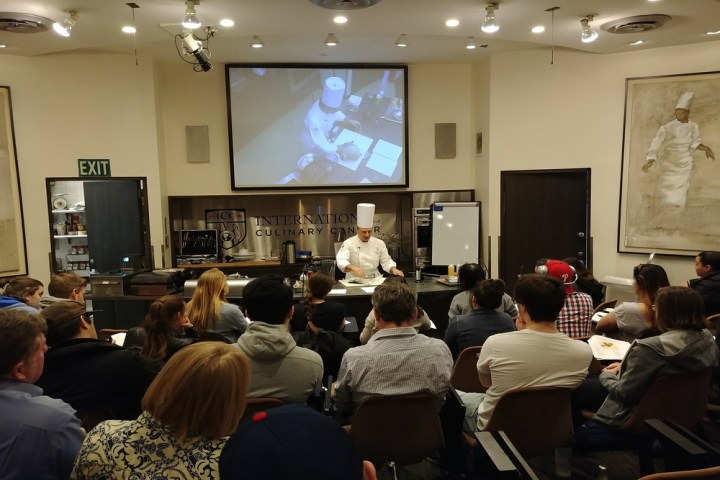
Hervé Malivert, the center’s director, is an accomplished gourmand. He joined the International Culinary Center in 2006, after a culinary study in France and a two-decade tour in the restaurant business. He’s a traditionalist — Malivert’s a card-carrying member of the Maître Cuisiniers de France (Master Chef of France), a 60-year-old society that’s among the most exclusive in the country — but one that’s not afraid of a little experimentation. Malivert made headlines last year when he worked alongside a Columbia engineering professor to prototype a 3D food printer.
To demonstrate the latest in high-tech cooking, Malivert invited Digital Trends to a three-course, brunch-themed cooking demo. Using techniques like “liquid nitrogen blending” and “immersion curing,” he whipped up dishes fit for Michelin. Here’s a taste of what we tried:
Olive Oil poached egg

The first dish was a modernist take on an egg sandwich — three olive oil-cured yolks topped with with salmon roe, mustard seed, and a crème fraiche garnish. Malivert described it as an omage to “Oeufs au Caviar,” a eggs-and-caviar dish served at Jean-Georges in New York. His take was a little less extravagant — he subbed salmon roe for caviar — but no less visually stunning.
It was also deceptively complicated. The yolks alone required two hours of prep work, Malivert said — one hour in a vacuum seal infused with herbs, spices, and simmering water, and another in an immersion circulator — a kitchen appliance that draws water from a tub or pot of water, heats it up to a precise temperature, and spits it back out.
The mustard seeds were just as labor-intensive. Once the seeds were blanched five times, they were pressure-cooked in a blend of rice vinegar, sugar, and salt. The finished mixture was transferred to a bain marie (a slow-cooking container immersed in hot water), and left to cool on ice.
But the wait was worth it. The tart mustard, creamy crème fraiche, buttery brioche, and fatty yolk left us smacking our lips.
Short ribs pastrami

The second dish — short ribs rubbed with peppercorn and finished with a gel-like fluid — was a little meatier than the first. But just like the olive oil-poached eggs before it, it wasn’t easy to assemble.
The short rib brine — a blend of salt, sugar, and rib fat — had been melding together in a refrigerator for five days, Malivert said. The pastrami had taken longer — once it was removed from the brine and rubbed with spices, it was smoked for four hours, then boiled, strained, cooled, vacuum-sealed, and cooked sous vide for 72 hours.
The fluid gel, a bright-colored substance that looked a little like thick ketchup, was the product of cooking liquid from the pastrami, vinegar, and sugar. It was brought to a boil, transferred to a container on ice to set, and blended in a food processor until smooth and creamy.
The dish was a stunner. The fluid gel’s sweetness complimented the melt-in-your-mouth pastrami beautifully, and the peppercorn rub lent just enough of a kick to keep things interesting.
Smoked Salmon en Brioche

Malivert’s last dish was featured brioche, salmon, an orange jam, and watercress puree.
The salmon wasn’t your weeknight dinner variety. It was seasoned and vacuum-sealed in a refrigerator for 12 hours, and infused with smoke from a smoking gun. The barbecue-like flavor paired perfectly with the final component: A slice of egg white-brushed brioche.
The jam was just as labor-intensive. Malivert cut oranges into slices in and combined them with sugar, and then pressure-cooked them in a canning jar for two hours before chilling them. Finally, he blended them with oil.
After whipping up a simple peas puree — a mix of watercress, shallots, and vice vinegar blended together until they reach a smooth consistency — and a pickled tomato, Malivert plated the final dish. And what a dish: The savory-and-sweet salmon and jam combination was our favorite of the evening.


